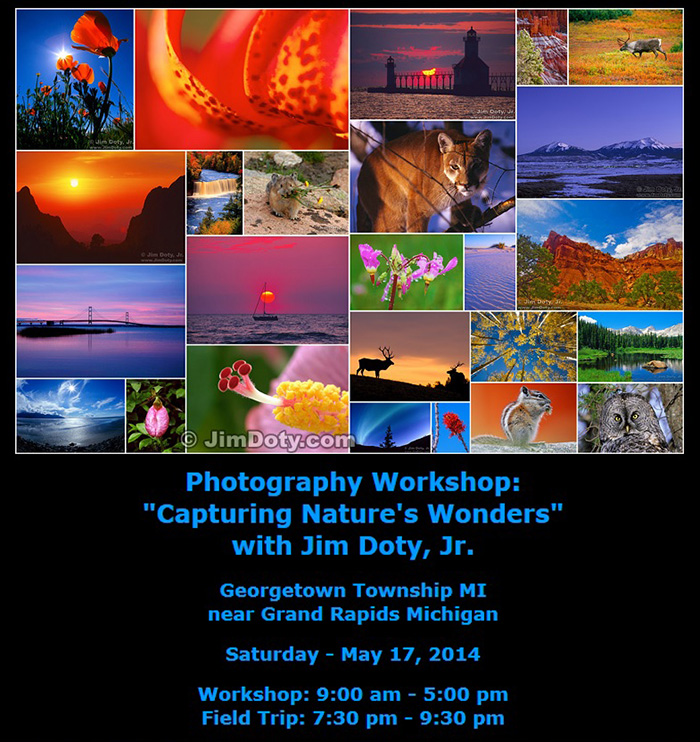Spend a fun and exciting day learning how to take your outdoor photography to the next level. You’ll receive “real time” instruction in the field, as well as intensive classroom preparation. In the classroom sessions, you will learn the steps that make the difference between ordinary snapshots and extraordinary images. Minutes later you will be outside practicing those steps. Best of all, you will go home knowing how to create eye-catching images!
You will learn:
Metering – The First Big Step Toward Great Images
Depth of Field – The Doorway to Dramatic Images
It’s all about the Light – Learning to “read”, work with, and use the light to put magic in your images
Playing with Time – Creating Images That Your Eyes Can’t SeeÂ
From Grand to Intimate – Landscapes Great and SmallÂ
From Bees to Birds to Bears – Putting your Best Paw Forward in Wildlife PhotographyÂ
Petals in the Wind – How to Create Beautiful Flower ImagesÂ
Outdoor Photography as Fine Art
Simplifying Tricky Situations – It’s Only Hard Until You Know How
Location
Georgetown Township Community Center
7096 – 8th Street, Georgetown Twp., Michigan
(616) 457-3270
Registration
Registration Fee: $50 at the time of registration (refunded in full if you cancel by April 19).
To register, contact Vickie Reynolds at:
vreyn11@att.netÂ
The workshop is limited to 20 participants. If you aren’t one of the first 20 to register you can be placed on a waiting list in priority order in case someone cancels.
The Workshop Leader
Jim Doty, Jr. has the ideal combination of practical photography experience and teaching skills to provide an inspiring workshop experience that will improve your photography.
Jim is a photography instructor with 18 years experience. He currently teaches photography at The Ohio State University. He has also taught at the Kalamazoo Institute of Arts and Graceland University in Iowa. During his workshops, seminars, and field trips he has worked with hundreds of photographers at all skill levels.
His images can be found in magazines, books, newspapers, calendars, tourist brochures, corporate reports, and on web sites for corporations and not-for-profit organizations.
Jim’s work has been published by the National Wildlife Federation, Black & White Magazine , The Ohio State University, Ohio Sea Grant, Stone Laboratory, Graceland University, UNCF (United Negro College Fund), Crowne Plaza Hotels, Staybridge Suites, Holiday Inn Hotels, Best Western Hotels, Hunt’s Guide to the Upper Peninsula, Heartland Tours and Travel, Midwest Photo Exchange, Wiley Publishing, Inc., The MichMatist, the Yukon Review, Magic 106.3, The Herald, Community of Christ, Presbyterian Church (PCUSA), Kirtland Temple Historic Site, KOA Campgrounds, and Terrapin World Imports.
Jim is the author of the highly recommended book Digital Photography Exposure for Dummies. It is rated 5 stars at Amazon.com.
Bring to the Workshop
A digital camera* and the camera manual. You will use your camera during the workshop.
A tripod if you have one.
A notebook or paper and pen or pencil to take notes.
A small flashlight or headlamp for the field trip.
If you have it, bring the recommended companion book for the workshop, Digital Photography Exposure for Dummies.
*Â To get the most out of this workshop you will need a camera that allows you to manually control apertures, shutter speeds, and ISO settings. A lens that has manual focus is also a plus. Any recent model DLSR (digital single lens reflex) or ILC (interchangeable lens compact), will work fine. If you have a full featured point and shoot camera that has the four basic PASM modes (Program, Aperture priority, Shutter priority, and Manual) and makes them easy to use, you will do just fine.
Before The Workshop
If you are new to photography or have a new camera, go through your camera’s manual prior to the workshop so you are well acquainted with its basic and less well known functions. Check out the PASM modes (see the paragraph just above this one), learn how to use them, and try them out before the workshop. If your camera has “mirror lock up”, “depth of field preview” or a “live view” mode, be sure and check them out and use them too. If your camera has a B (for bulb) mode, learn how to access it and use it (it might be hidden in the camera’s menu section).
If you have Digital Photography Exposure for Dummies, reading chapters 2, 3, and 4 before the workshop would be very helpful.

